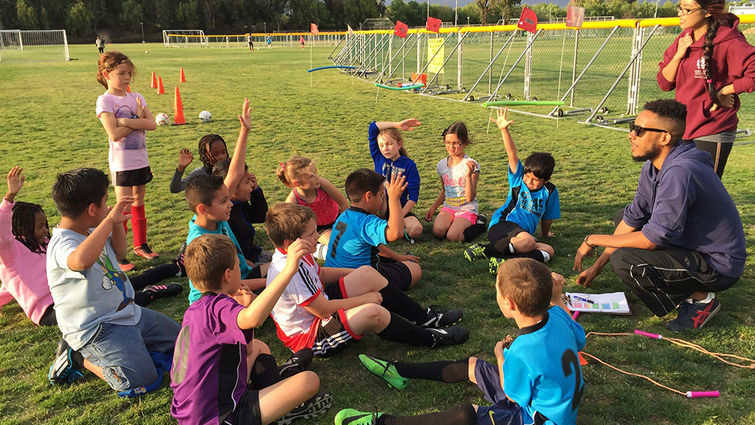
At Loma Linda University, service learning takes place throughout the year. Here, students coach a soccer team during a service learning opportunity.
“’I am somebody.’ Upon hearing this personal disclosure, I was reminded that despite [differences] they are people with hopes and dreams just like me.”
Revelations like this one, experienced by a master of public health student who had just completed a service learning course, often occur after engaging in the community.
According to Brenda Spoelstra, of the Loma Linda University Institute for Community Partnerships, this deepened understanding was recently expressed by a Loma Linda University student who had worked with school kids in San Bernardino.
“Service learning expands the classroom to the community, where learning is bi-directional, between students and community members,” says Spoelstra. “The word that describes this is reciprocity—both parties benefit through a common experience.
“At Loma Linda University, many of our students only have a short amount of time in the community as part of a service learning course, so it is important to have careful preparation and structured activities that keeps the student focused on what is important to the community.”
Loma Linda University students provide dental care at elementary schools; feed the homeless at a local mission and introduce kids to performance arts through music lessons.
As nursing students provide mental health care to teens in group homes, and public health students teach after-school programs on nutrition they learn about important factors such as the social determinants of health or barriers to accessing health and social services in the community.
“Often there is an increased awareness in our students of not only community needs, but of the community’s strengths,” emphasizes Spoelstra.
After a memorable shared experience with people in a local, underserved community, a student reflected: “This connection goes to show you that all too often we as people are more similar than different.”
Service learning can lead to many discoveries for the student and stereotypes can be challenged as the students interact with those closest to the issue. These experiences put a face and soul to homelessness, immigration, single parenthood and other societal challenges where the student’s experience seldom gets past the label.
An opportunity is created to acknowledge and strive for reciprocity, which becomes the anchor and a guiding principle in these new relationships.
“I have learned from the youth that I should never give up and look on the bright side,” wrote a Loma Linda University student. “I should not let anything get in my way and I should try my best in everything that I do. Working with [teen parents] has changed a lot of my views in life and has taught me to be a stronger person.”
As they participate in service learning, students gain professional skills through real world experiences with the community. These include skills like communication, leadership and teamwork and other less tangible but important traits such as empathy, initiative, accountability, excellence, compassion and an open mind that creates a willingness to listen and learn from the community.
Exposure to people from many racial, ethnic, religions, socio-economic backgrounds supports development of the nuances in professionalism that are vital in the health care professions.
“Many societal problems are addressed,” says Spoelstra, “when organizations and institutions work with communities instead of just in communities. We hope that our students, through their service learning experience, will learn this and take it with them into their personal and professional lives.”
At Loma Linda University Health, service learning activities are under the direction of the Institute for Community Partnerships.
